

What does the LGBTQIA+ stand for?
Acronym for lesbian, gay, bisexual, transgender, queer or questioning, intersex, agender or asexual and "+" for the other identities and labels. LGBT and LGBTQ+ are also used, with the + added in recognition of all non-straight, non-cisgender identities.
Ask people how they describe themselves before labeling their sexual orientation or gender identity.
Sexual Orientation
The scientifically accurate term for an person’s enduring physical, romantic and/ or emotional attraction to another person. Sexual orientations can include heterosexual (straight), lesbian, gay, bisexual, queer, asexual, and other orientations. People need not have had specific sexual experiences to know their own sexual orientation; in fact, they need not have had any sexual experience at all.
Gender identity and sexual orientation are not the same.

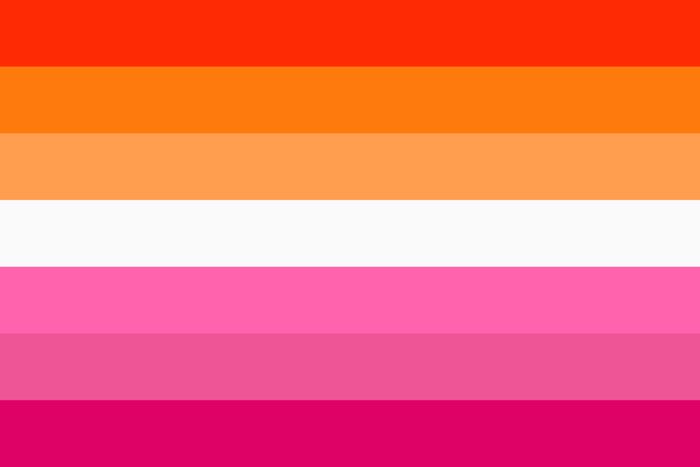
Lesbian
A woman whose enduring physical, romantic, and/or emotional attraction is to other women. Some lesbians may prefer to identify as gay (adj.) or as gay women. Avoid identifying lesbians as "homosexuals.” Lesbian can be used as a noun or adjective.
Although there are multiple versions of the Lesbian Pride Flag, this one—which has been around since 2018—appears to be the one that’s most widely embraced. The seven different shades of pink, orange, white, and red were used to represent different types of femininity.

Gay
An adjective used to describe a person whose enduring physical, romantic, and/ or emotional attractions are to people of the same sex (e.g., gay man, gay people). Avoid identifying gay people as "homosexuals" an outdated term considered derogatory and offensive to many lesbian and gay people.
This is the new, more accepted and widely used version of a flag for gay men specifically created by user gayflagblog on 10th July 2019.
"The green (Community) and teal (Joy) in the flag represent Nature. I thought this was important because love between men is often seen as “unnatural” in the eyes of society and in religion. Furthermore, gay men have historically used green flowers and plants (Carnations, hyacinths, etc.) to symbolize our love, reinforcing our connection with Nature. The white stripe is adopted from the Trans Pride flag because trans, nb, and GNC men are often erased or talked over and need explicit representation. We have a lot of unadressed and blatant Transphobia, internalized Homophobia, and Toxic Masculinity directed towards GNC/non-cis men in our community that we need to address and resolve. The purple (Fortitude) and indigo (Diversity) in the flag represent diversity in presentation, relationships, & life experience. We’re so often stereotyped as all fitting into these neat little categories, especially by those who choose to fetishize us & by non-MLM, but in reality there are so so many different ways to be a man and so many ways to be a man who loves or who is in a relationship with other men, and this needs to be emphasized. Purple is a mix of blue and red, and seeing as common criticism of other gay man flag proposals is “oh blue for boy? bleh”, I decided to have a light blue stripe leading into a deep purple to symbolize how some of us might be stereotypical, some of us might not be, and some of us are in-between or fluid. Regardless, we should all be celebrated and respected. This flag is inclusive of all gay (men loving men) men."
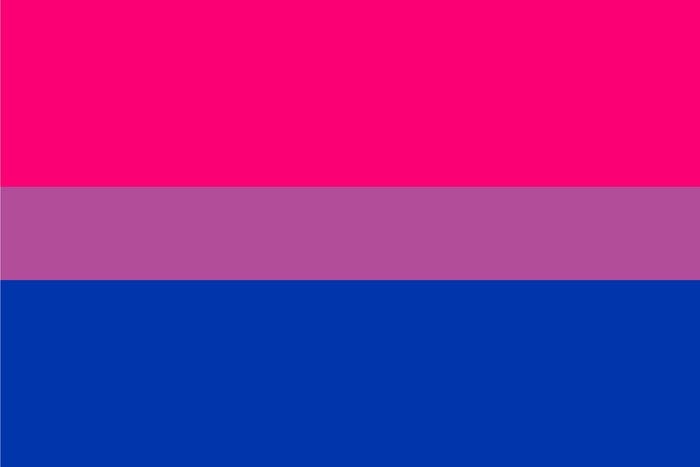
Bisexual, Bi, Bi+
An adjective used to describe a person who has the potential to be physically, romantically, and/or emotionally attracted to people of more than one gender, not necessarily at the same time, in the same way, or to the same degree. The bi in bisexual refers to genders the same as and different from one's own gender.
People may experience this attraction in differing ways and degrees over their lifetime. Some people use the words bisexual and bi to describe the community. Others may use bi+ which is intended to be inclusive of those who call themselves bisexual, pansexual, fluid, queer and other words which describe people who have the potential to be attracted to more than one gender. Similar to questioning, people might say they are bicurious if they are exploring whether or not they are attracted to people of the same gender as well as people of other genders.
Florida-based LGBTQ activist Michael Page created the Bisexual Pride Flag in 1998 to increase the visibility of bisexual individuals—who are attracted to two genders—in both the LGBTQ community and society as a whole. The pink represents attraction to those of the same gender identity, while the blue stands for attraction to people who identify as a different gender. The purple stripe in the middle symbolizes attraction to two genders.
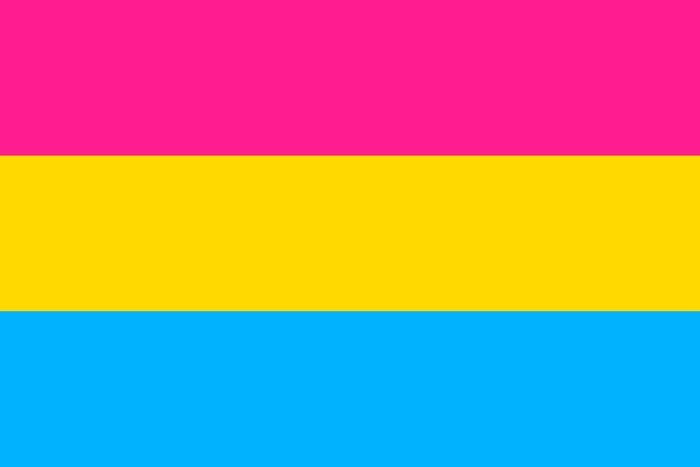
Pansexual
An adjective used to describe a person who has the capacity to form enduring physical, romantic, and/ or emotional attractions to any person, regardless of gender identity.
Pansexual folks—who are attracted to people regardless of their gender identity—got their own flag around 2010. It was created to both increase their overall visibility and help differentiate the group from bisexual individuals. Here, the pink represents attraction to people who identify as female, while the blue stands for attraction to those who identify as male. The yellow stripe in the middle represents attraction to those who identify as genderqueer, nonbinary, agender, androgynous, or anyone who doesn’t identify on the male-female binary.
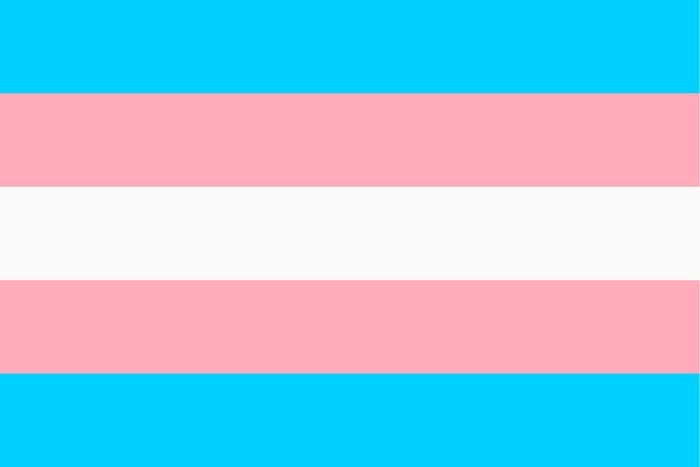
Transgender
An adjective to describe people whose gender identity differs from the sex they were assigned at birth. People who are transgender may also use other terms, in addition to transgender, to describe their gender more specifically.
Use the term(s) the person uses to describe themself. It is important to note that being transgender is not dependent upon physical appearance or medical procedures. A person can call themself transgender the moment they realize that their gender identity is different than the sex they were assigned at birth.
The Transgender Pride Flag has been around since 1999, when an American transgender Navy veteran named Monica Helms created it. A year later, the flag made its debut at a Pride parade in Phoenix. Light blue and pink are featured because they’re the traditional colors associated with baby boys and girls, respectively. The white represents those who are intersex, transitioning, or see themselves as having a neutral or undefined gender.

Queer
An adjective used by some people, particularly younger people, whose sexual orientation is not exclusively heterosexual (e.g. queer person, queer woman). Typically, for those who identify as queer, the terms lesbian, gay, and bisexual are perceived to be too limiting and/or fraught with cultural connotations they feel do not apply to them.
Once considered a pejorative term, queer has been reclaimed by some LGBTQ people to describe themselves. However, it is not a universally accepted term even within the LGBTQ community, so use caution when using it outside of describing the way someone self-identifies or in a direct quote.
When Q is seen at the end of LGBT, it typically means queer. In a setting for support, particularly for youth, it may mean questioning.
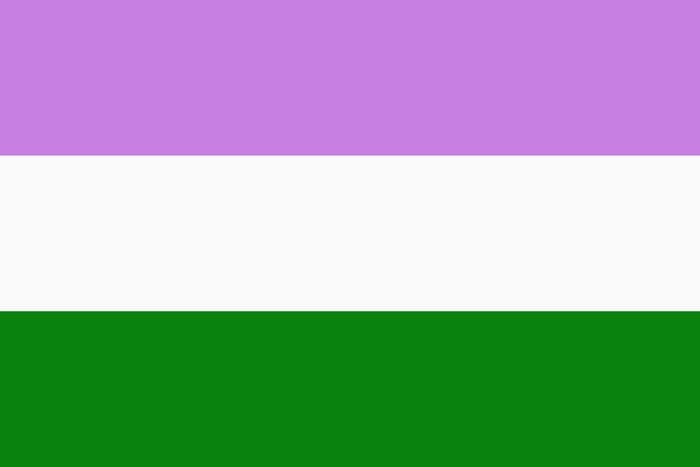
Genderqueer Pride Flag, which writer and activist Marilyn Roxie designed in 2011 with input from the readers of the website Genderqueer Identities. As the combination of the traditionally masculine and feminine colors (blue and pink), lavender represents androgyny and other queer identities, while white stands for agender identity and green represents those whose identities are defined outside the binary.
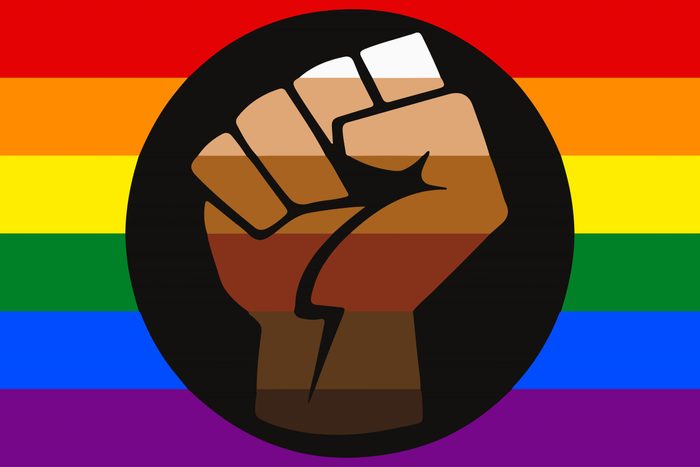
Although the flag’s designer and year of creation are unknown, the Queer People of Color (QPOC) Pride Flag made an appearance at San Francisco Pride in 2019 and rose to prominence in 2020. The raised clenched fist in the center of the traditional rainbow flag indicates solidarity with the Black Lives Matter movement. The QPOC flag also represents how intertwined the queer community and people of color have been over the years in their fight for equality, including in the early days of the queer liberation movement and the work of activist Marsha P. Johnson.
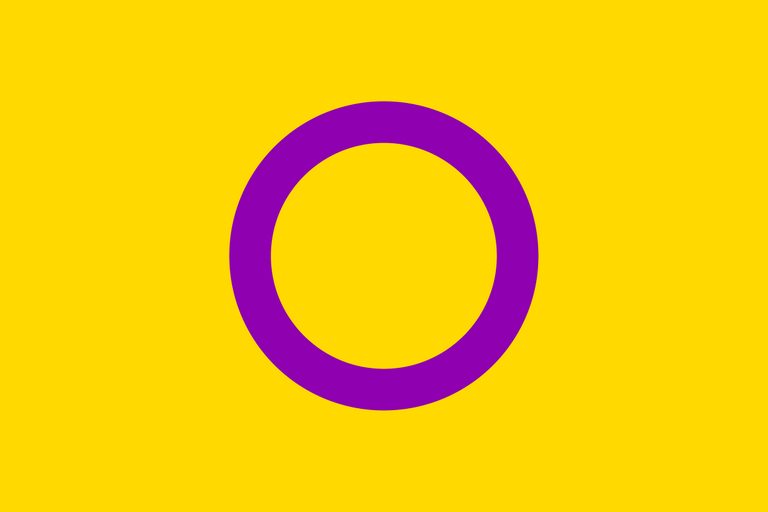
Intersex
Intersex is “an umbrella term describing people born with reproductive or sexual anatomy and/or a chromosome pattern that can't be classified as typically male or female.” An adjective used to describe a person with one or more innate sex characteristics, including genitals, internal reproductive organs, and chromosomes, that fall outside of traditional conceptions of male or female bodies. Do not confuse having an intersex trait with being transgender. Intersex people are assigned a sex at birth — either male or female — and that decision by medical providers and parents may not match the gender identity of the child.
The A is used to represent those who identify as asexual or those who are agender.
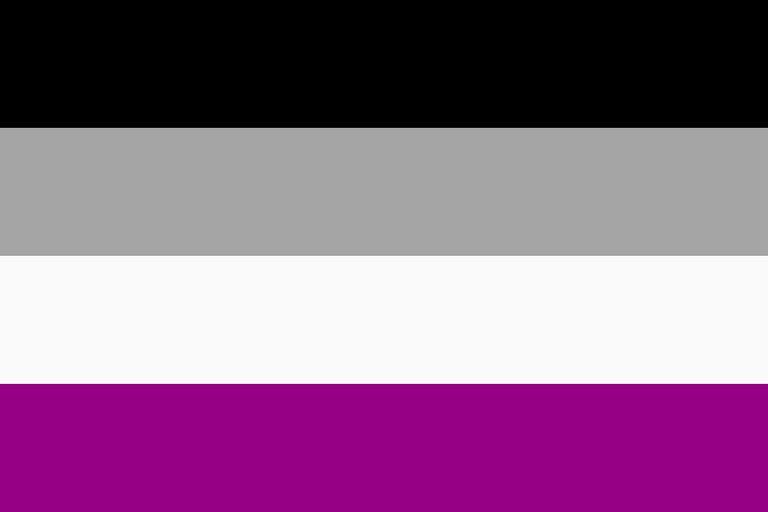
Asexual
An adjective used to describe a person who does not experience sexual attraction (e.g., asexual person). Sometimes shortened to "ace." Asexual is an umbrella term that can also include people who are demisexual, meaning a person who does experience some sexual attraction, but only in certain situations, for example, after they have formed a strong emotional or romantic connection with a partner.
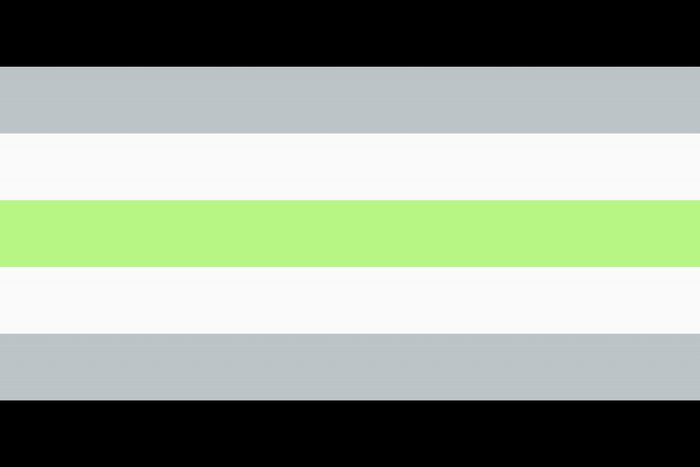
Agender
Agender Pride Flag created in 2014 by New York–based artist and activist Salem X, the Agender Pride Flag represents people who identify as having no gender, an unidentifiable gender, or being gender neutral. There are a total of seven stripes: two black, two gray, two white, and one green, with each color having its own meaning:
Black: The absence of gender
White: The absence of gender
Gray: Semi-genderless
Green: Nonbinary genders
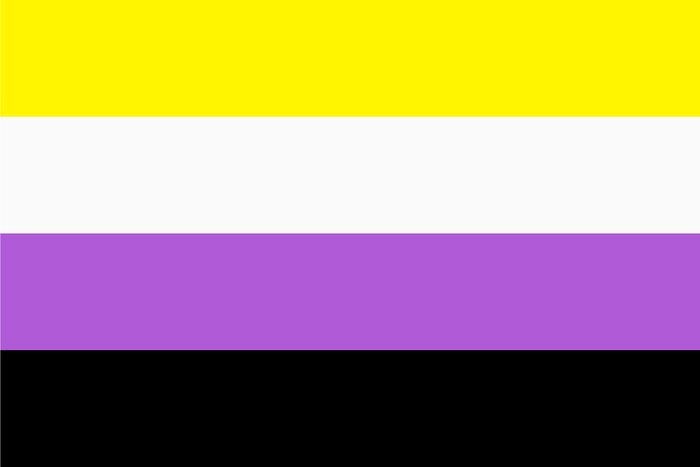
Nonbinary
Nonbinary is an adjective used by people who experience their gender identity and/or gender expression as falling outside the binary gender categories of man and woman. Many nonbinary people also call themselves transgender and consider themselves part of the transgender community. Others do not. Nonbinary is an umbrella term that encompasses many different ways to understand one's gender. Some nonbinary people may also use words like agender, bigender, demigender, pangender, etc. to describe the specific way in which they are nonbinary. Always ask people what words they use to describe themselves. Nonbinary is sometimes shortened to enby.
This LGBTQ flag was created in 2014 to represent nonbinary people, whose gender identity does not fit within the traditional male/female binary. The goal wasn’t to replace the Genderqueer Pride Flag but to fly the Nonbinary Pride Flag alongside it. Its colors symbolize those whose gender falls outside of and without reference to the binary (yellow), people with many or all genders (white), those whose gender identity falls somewhere between male/female or is a mix of them (purple), and people who feel they are without a gender (black).
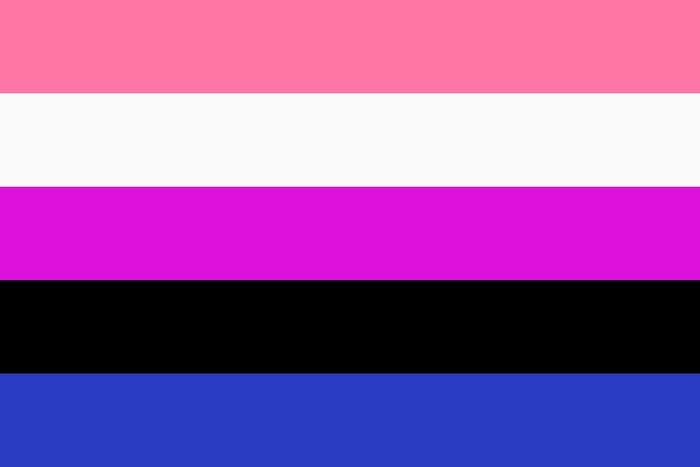
Genderfluid
JJ Poole created the Genderfluid Pride Flag in 2013 to represent folks whose gender identity and/or expression is fluid and may fluctuate at different times or in different circumstances. The flag has five horizontal stripes of different colors representing femininity (pink), lack of gender (white), a combination of both masculinity and femininity (purple), all genders anywhere on the spectrum (black), and masculinity (blue).

Other Identities
Allosexual
An adjective used to describe a person who experiences sexual attraction to others, and is not asexual (e.g., allosexual person).
Androsexual/Androphilic
An adjective used to describe a person who is primarily sexually, aesthetically, and/or romantically attracted to masculinity.
Aromantic
An adjective used to describe a person who does not experience romantic attraction. Aromantic is an umbrella term that can also include people who are demiromantic, meaning a person who does not experience romantic attraction until a strong emotional or sexual connection is formed with a partner.
Gynesexual/gynephilic
An adjective used to describe a person who is primarily sexually, aesthetically, and/or romantically attracted to femininity.
Heterosexual
An adjective used to describe a person whose enduring physical, romantic, and/ or emotional attraction is to people of a sex different than their own. Also: straight.
Homosexual
Outdated clinical term considered derogatory and offensive.
Questioning
An adjective used by some people who are in the process of exploring their sexual orientation and/or gender identity.
Same-Gender Loving
Also known as SGL, this is a term used by some African American people as an Afrocentric alternative to what are considered Eurocentric, or white, identities like gay and lesbian. Coined by activist Cleo Manago in the 1990s, the term and its usage explicitly recognizes the histories and cultures of people of African descent.
Two-Spirit
An adjective used by some Indigenous and First Nations people as an umbrella term to describe people who are not straight and/or cisgender. Many Indigenous communities have specific words in their language to describe these experiences, but some do not. This term should not be used to describe people who are not Indigenous. Only use it for an Indigenous person if they use it to describe themselves.

Source : https://www.glaad.org/reference/terms & https://www.rd.com/list/lgbtq-flags/
Edited by DelusionsOfNeha - 1 years ago

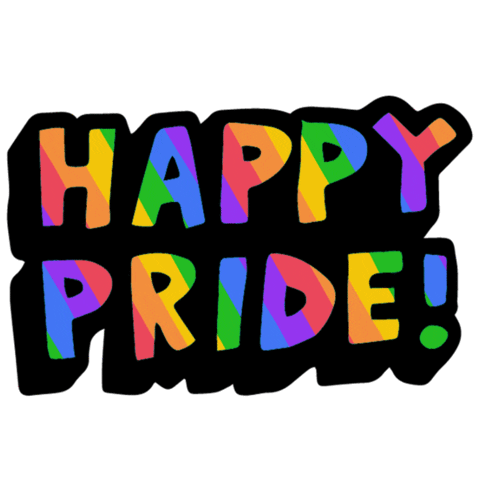


![]()























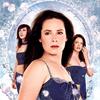




comment:
p_commentcount